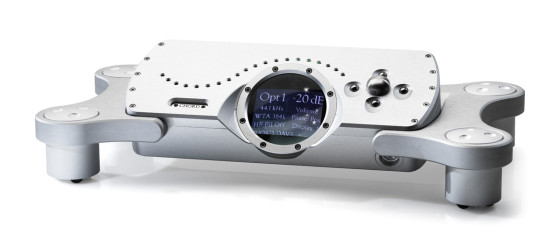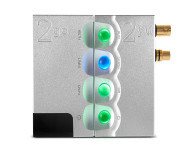
After hearing Meridian’s founder Bob Stuart convincingly criticizing compressed digital audio formats and explaining how digital technology has been unable to capture the true essence of a live performance, no matter how high the resolution and sampling frequency available in consumer formats - one would be tempted to completely ignore digital audio technology and resort to listening only to analogue tape or vinyl.
But while some companies, like Meridian, are going “back to basics” and are determined to reinvent all the digital encoding and decoding process, starting from existing analogue master recordings or directly creating “quality authenticated” iterations of a studio master, there are other companies who believe that, whatever the original digital format will be – including high-resolution PCM, DXD and Quad DSD - there is a way to recover more (audible, we assume…) information from it, using advanced digital-to-analogue techniques.
That’s precisely what Chord Electronics proposes with DAVE (acronym for Digital to Analogue Veritas in Extremis, according to the company), its latest-generation digital-to-analogue convertor featuring “the very best conversion technology available, using proprietary techniques never seen before.”
DAVE was introduced at the 2015 High End Munich show and immediately created lots of excitement in the high-end hi-fi world. Coming from one of the world’s leading amplifier designer and manufacturer, this new advanced solution certainly deserves some attention - and that’s why we decided to publish the available information.
Typically, product launches from high-end companies don’t allow much space for science and facts. Usually they prefer inviting selected journalists to hear for themselves and describe their highly-subjective experiences in their own words.
Without doing that, we have to resort to the information made available by the manufacturer and which the public-relation firms translate into little less than pure promotional material. All we can do is remove the excess of marketing terms and replicate the few available statements describing the product.

According to Chord, DAVE is “hand-made in Kent” (looking at the exquisite mechanical work of Chord’s new generation chassis, using carefully machined aircraft-grade aluminum that’s certainly an ambiguous statement) and is based around a proprietary FPGA (Field Programmable Gate Array) offering more than ten times the program capacity of its predecessor (which we assume to be the QBD76 HDSD DAC).
At the heart of DAVE is an LX75 version of the Spartan 6 Field Programmable Gate Array (Xilinx), which Chord explains enables “a number of key sonic benefits including significantly improved timing and the best noise-shaper performance of any known DAC.” That particular FPGA platform allowed Chord to implement “a brand new WTA (Watts Transient Aligned) filter with 164,000 taps” - which we humbly confess having no idea about what it implies.
And again, we have to resort to the brand’s description: “WTA filtering is now up to 256 FS (that’s 256-times the sample frequency) — no other DAC has ever FIR filtered at such a high rate! In order to process signals at this unprecedented rate, DAVE has massive parallel-processing capacity with 166 separate DSP cores just for the WTA filtering alone. This enables DAVE to reproduce the original unsampled analogue signal more accurately than any other DAC.”
Taking again the manufacturer own words, the output stage “has been advanced with a new 20-element Pulse Array DAC and a unique second-order analogue noise-shaper, which gives ultra-high-frequency linearity. Its output feeds both balanced XLR and single-ended RCA outputs, as well as an advanced headphone output with more than enough capability for the most impedance-challenging headphones.”
A key benefit over its predecessor, according to Chord, is a full-sized LCD display, showing input, sample frequency and volume, plus set-up and configuration options. The display, which sits behind the famous Chord porthole, is clearly visible from a variety of angles and retains the signature color display for volume and sample rate as introduced by the landmark Hugo DAC/headphone amp. On its fascia, DAVE also features a rotary encoder with a large stainless steel controller and ball buttons, enabling direct interactivity in addition to the supplied remote control.
As previously explained, DAVE’s advanced technology is “enshrined in Chord Electronics’ trademark casework which has been precision-milled from solid aircraft-grade aluminum to deliver functional strength and rigidity, as well as great beauty.” That part, we have to completely agree.

And finally, Chord provides the important information in a specification list, which we duplicate here:
Inputs:
USB B-style 44 kHz to 768 kHz
DXD and Quad DSD
2x optical 44kHz to 192kHz
1 x AES 44kHz to 192kHz
4 x Coax 44kHz to 384kHz
Dual-data mode available
Outputs digital:
2x ultra-high-speed coax 768kHz dual-data mode (for use with future-unannounced Chord Electronics products)
Maximum output voltage: 6 volts RMS
THD and noise at 2.5 volts: RMS 0.000015 %
THD and noise at 2.5 volts: 127dBA Awt (124dBA into 33 ohms)
Dynamic range at -60 dBFS 1kHz -127 dBA A wt
(No measurable noise floor modulation, no harmonic distortion)
(Analogue distortion characteristic: no distortion for small signals)
Power requirements: mains power 80 volts to 260 volts; AC 20 watts
www.chordelectronics.co.uk






